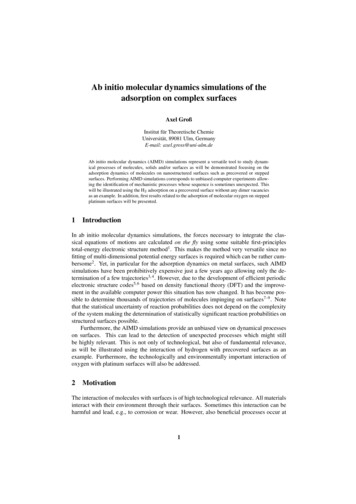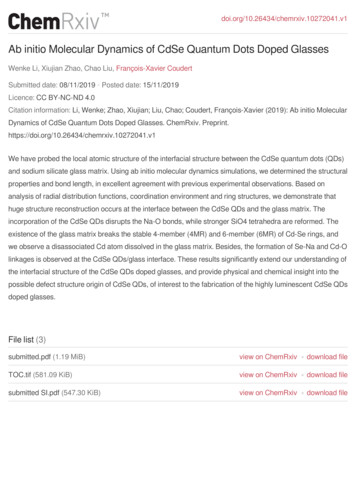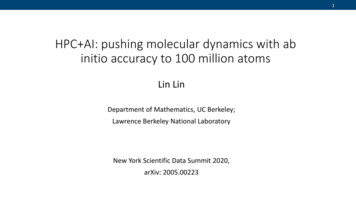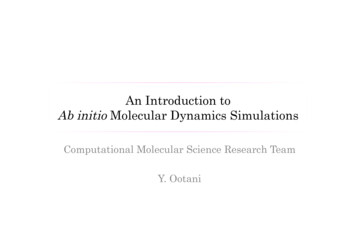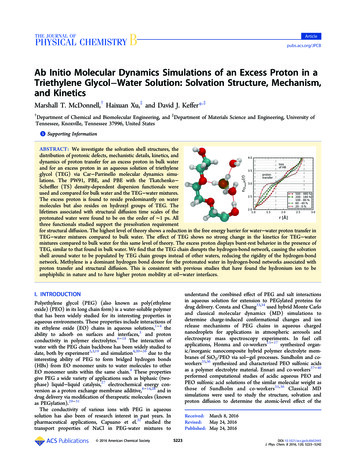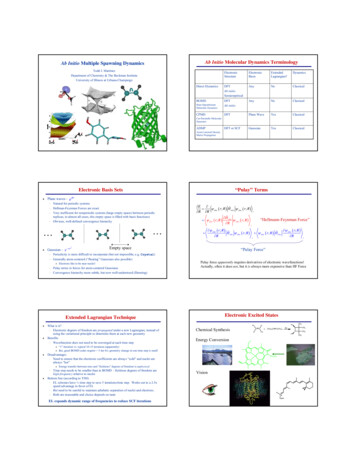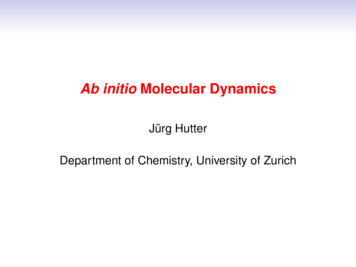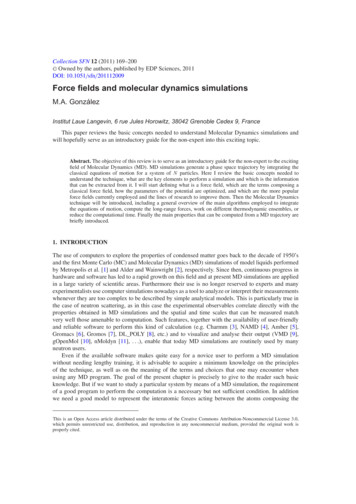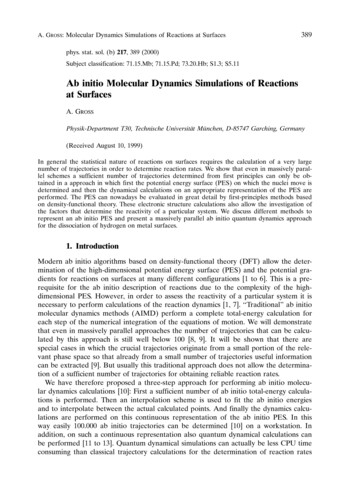
Transcription
A. Gross: Molecular Dynamics Simulations of Reactions at Surfaces389phys. stat. sol. (b) 217, 389 (2000)Subject classification: 71.15.Mb; 71.15.Pd; 73.20.Hb; S1.3; S5.11Ab initio Molecular Dynamics Simulations of Reactionsat SurfacesA. GrossPhysik-Department T30, Technische UniversitaÈt MuÈnchen, D-85747 Garching, Germany(Received August 10, 1999)In general the statistical nature of reactions on surfaces requires the calculation of a very largenumber of trajectories in order to determine reaction rates. We show that even in massively parallel schemes a sufficient number of trajectories determined from first principles can only be obtained in a approach in which first the potential energy surface (PES) on which the nuclei move isdetermined and then the dynamical calculations on an appropriate representation of the PES areperformed. The PES can nowadays be evaluated in great detail by first-principles methods basedon density-functional theory. These electronic structure calculations also allow the investigation ofthe factors that determine the reactivity of a particular system. We discuss different methods torepresent an ab initio PES and present a massively parallel ab initio quantum dynamics approachfor the dissociation of hydrogen on metal surfaces.1. IntroductionModern ab initio algorithms based on density-functional theory (DFT) allow the determination of the high-dimensional potential energy surface (PES) and the potential gradients for reactions on surfaces at many different configurations [1 to 6]. This is a prerequisite for the ab initio description of reactions due to the complexity of the highdimensional PES. However, in order to assess the reactivity of a particular system it isnecessary to perform calculations of the reaction dynamics [1, 7]. Traditionalº ab initiomolecular dynamics methods (AIMD) perform a complete total-energy calculation foreach step of the numerical integration of the equations of motion. We will demonstratethat even in massively parallel approaches the number of trajectories that can be calculated by this approach is still well below 100 [8, 9]. It will be shown that there arespecial cases in which the crucial trajectories originate from a small portion of the relevant phase space so that already from a small number of trajectories useful informationcan be extracted [9]. But usually this traditional approach does not allow the determination of a sufficient number of trajectories for obtaining reliable reaction rates.We have therefore proposed a three-step approach for performing ab initio molecular dynamics calculations [10]: First a sufficient number of ab initio total-energy calculations is performed. Then an interpolation scheme is used to fit the ab initio energiesand to interpolate between the actual calculated points. And finally the dynamics calculations are performed on this continuous representation of the ab initio PES. In thisway easily 100.000 ab initio trajectories can be determined [10] on a workstation. Inaddition, on such a continuous representation also quantum dynamical calculations canbe performed [11 to 13]. Quantum dynamical simulations can actually be less CPU timeconsuming than classical trajectory calculations for the determination of reaction rates
390A. Grossbecause the averaging over initial conditions is done automatically in quantum mechanics by choosing the appropriate initial quantum states [10].In this paper, we will illustrate the three-step approach for the example of dissociation of hydrogen on clean and adsorbate-covered metal surfaces. We will also show thatthe electronic structure calculations can be used in order to understand the factors determining the reactivity of a particular surface. Furthermore, we will introduce a massively parallel implementation of the very stable coupled-channel scheme [14] we haveused to solve the time-independent SchroÈdinger equation of the interaction of hydrogenwith metal surfaces. Because of the use of curvelinear reaction path coordinates thisscheme requires the diagonalisation of non-symmetric matrices. Due to the lack of massively parallel public domain diagonalisation schemes for general matrices we implemented a second order pertubation diagonalisation scheme. We will present results concerning the performance and scaling properties of this ab initio quantum dynamicsscheme.2. AIMD with the Determination of the Forces on the FlyºThe first ab initio molecular dynamics study of reactions at surfaces with the determination of the forces on the flyº was an investigation of the adsorption of Cl2 on Si(111)2 1 [8]. Only five trajectories were determined in this study so that the informationabout the reaction dynamics gained from this study was rather limited.Here we focus on a more recent example, the desorption of hydrogen from Si(100).The interaction of hydrogen with silicon surfaces is of strong technological relevance.On the one hand, hydrogen is used to passivate silicon surfaces, on the other hand,hydrogen desorption from silicon is an important step in the chemical vapor deposition(CVD) growth of silicon substrates.It is a well-studied system [1, 15], but still it is discussed very controversely, as far as experiment [16 to 18] as well as theory is concerned[9, 19]. One of the debated issues is the role of the surface rearrangement of the siliconsubstrate degrees of freedom upon the adsorption and desorption of hydrogen.In Fig. 1 this surface rearrangement is illustrated for the Si(100) surface. While at thehydrogen covered monohydride surface the outermost silicon atoms form symmetricdimers (Fig. 1a), at the clean surface these dimers are buckled (Fig. 1c). Consequently,Fig. 1. a) Hydrogen covered Si (100) surface (monohydride). b) Snapshots of a trajectory of D2desorbing from Si (100) starting at the transition state with the Si atoms initially at rest [9]. Thedark Si atoms correspond to the Si positions after the desorption event. c) Clean anti-buckledSi (100) surface [9]
Molecular Dynamics Simulations of Reactions at Surfaces391the silicon surface atoms participate in the hydrogen adsorption and desorption process.In order to investigate the energy redistribution among the different hydrogen and silicon substrate degrees of freedom upon the desorption of hydrogen from Si(100) wehave performed AIMD calculations [9] using the Generalized Gradient Approximation(GGA) for the treatment of the exchange and correlation effects. The forces necessaryto integrate the equations of motion were determined by DFT calculations for everystep of the numerical integration routine. The electronic wave functions were expandedin a plane-wave basis set with a cutoff of 40 Ry, and we used two k-points in the irreducible part of the Brillouin zone. The calculations had been performed using the massively parallel version of the fhi96md code [20]. We chose a time step of 1.2 fs in thenumerical integration of the motion which took about 20 min on 64 nodes of a Cray T3D.In total 40 trajectories of D2 desorbing form Si(100) have been determined in that fashion. Fig. 1b shows some snapshots of such a trajectory. It illustrates how the siliconatom beneath the desorbing D2 molecule relaxes after the desorption thereby gaining akinetic energy of about 0.1 eV.However, the number of 40 trajectories is usually much too small to determine anyreaction probabilities. Only in certain cases as the hydrogen desorption from Si(100)where the crucial trajectories originate from a small portion of the relevant phase spaceone can still get reasonable information out of a small number of trajectories. The results of the AIMD calculations were in good quantitative agreement with the experiment [9], except for the experimentally observed low kinetic energy of desorbing D2molecules [16] which is still highly debated [1].Usually the calculation of reaction probabilities requires the determination of theorder of 103 to 106 trajectories or a quantum dynamical scheme. Ab initio moleculardynamics simulations with the determination of the forces on the flyº are still far awayfrom fulfilling this requirement, as was just shown. The calculation of ab initio reactionprobabilities can only be achieved by a three-step approach which will be presented inthe next section.3. Three-Step Approach to AIMD3.1 Determination of the ab initio potential energy surfaceThe first step in the general scheme for determining the ab initio dynamics of reactionsat surfaces is represented in Fig. 2, namely the determination of the ab initio PES bydensity-functional theory calculations [4]. It has turned out that it is crucial to treat theexchange correlation effects in the DFT calculations within the generalized gradientapproximation (GGA) in order to obtain realistic barrier heights for the hydrogen dissociation on surfaces [2]. For the hydrogen dissociation on close-packed metal surfacesusually the surface rearrangement upon hydrogen adsorption is negligible. Still totalenergies for several hundred different configurations have to be determined in order togain sufficient information about the PES as a function of the molecular coordinates.For the PES of the interaction of hydrogen with Pd(100) total energies of approximately 250 different configurations were calculated. In a later study energies for morethan 750 different configurations were computed [21] which resulted in a better agreement of the dynamical calculations based on these ab initio input points with the experiment [7].
392A. GrossAs Fig. 2 shows, the PES of the interaction of hydrogen with Pd(100) has non-activated paths towards dissociative adsorption and no molecular adsorption well. However,the majority of pathways towards dissociative adsorption has in fact energy barriers witha rather broad distribution of heights and positions, i.e. the PES is strongly anisotropicand corrugated. That is the reason why so many DFT calculations are needed.The DFT-GGA calculations can also be used in order to understand the electronicfactors that determine the reactivity of a surface [22 to 24]. We will illustrate this forthe case of the H2 dissociation at the (2 2) sulfur-covered Pd(100) surface. The pre-Fig. 2. Contour plots of the PES along two two-dimensional cuts through the six-dimensional coordinate space of H2 /Pd (100), so-called elbow plots, determined by GGA calculations [4]. The coordinates in the figure are the H2 center-of-mass distance from the surface Z and the H H interatomic distance d. The lateral H2 center-of-mass coordinates in the surface unit cell and theorientation of the molecular axis are depicted above the elbow plots. Energies are in eV per H2molecule. The contour spacing in a) is 0.1 eV, while it is 0.05 eV in b)
Molecular Dynamics Simulations of Reactions at Surfaces393sence of an adsorbate on a surface can profoundly change the surface reactivity. Anunderstanding of the underlying mechanisms and their consequences on the reactionrates is of decisive importance for, e.g., designing better catalysts. Sulfur is known toreduce the reactivity of the Pt-based car exhaust catalyst, hence it is important to analyse the reasons for this so-called poisoning. Hydrogen adsorption on Pd(100) can beused as a model system because on Pd(100) sulfur preadsorption also leads to the poisoning, i.e., the hydrogen dissociation is no longer non-activated as on the cleanPd(100) surface.This is demonstrated in Fig. 3 where we have collected four elbow plots of the hydrogen dissociation on the (2 2) sulfur covered Pd(100) surface determined by GGADFT calculations [22, 24]. These calculations show that hydrogen dissociation on sulfurcovered Pd(100) is still exothermic, however, the dissociation is hindered by the formation of energy barriers in the entrance channel of the PES. The minimum barrier, whichis shown in Fig. 3a, has a height of 0.1 eV and corresponds to a configuration in whichthe H2 center of mass is located above the fourfold hollow site. This is the site which isfarthest away from the sulfur atoms in the surface unit cell. The closer the hydrogenmolecule is to the sulfur atoms on the surface, the larger the barrier towards dissociative adsorption becomes. Directly over the sulfur atoms the barrier has a height of2.5 eV. To our knowledge, this is the most corrugated surface for dissociative adsorptionstudied so far by ab initio calculations.In order to understand the origins for the formation of this huge variety in the barrierheights, we have analysed the density of states (DOS) for the H2 molecule in these different geometries. The information provided by the density of states alone is often not sufficient to assess the reactivity of a particular system. It is also essential to know the character of the occupied and unoccupied states. For the dissociation the occupation of thebonding sg and the anti-bonding s*u H2 molecular levels and of the bonding and antibonding states with respect to the surface molecule interaction are of particular importance. We will see that the barrier distribution of the H2 dissociation over (2 2)S/Pd(100) can be understood by a combination of direct and indirect electronic effects.The DOS for the situation without any interaction between molecule and surface, i.e,when the H2 molecule is still far away from the surface, is shown in Fig. 4a. However,the electronic states of the adsorbed sulfur, in particular the p orbitals, are stronglyhybridized with the Pd d states. The d band at the surface Pd atoms is broadened andshifted down somewhat with respect to the clean surface due to the interaction with theS atoms [24]. The intense peak in the hydrogen DOS at ÿ4:8 eV which corresponds tothe sg state is degenerate with the sulfur related bonding state at ÿ4:8 eV. This degeneracy, however, is accidental, as will become evident immediately.When the molecule comes closer to the surface, the sg state starts interacting with thePd d band. At the minimum barrier position of Fig. 3a the sg state has shifted down toÿ7:1 eV, as Fig. 4b shows. On the other hand, the sulfur state at ÿ4:8 eV remains almost unchanged. This indicates that there is no direct interaction between hydrogenand sulfur. Furthermore, we find a broad distribution of hydrogen states with a small,but still significant weight below the Fermi level. These are states of mainly H2 -surfaceantibonding character [22, 24] which become populated due to the sulfur induced downshift of the Pd d band. These H2 -surface antibonding states lead to a repulsive interactionand thus to the building up of the barriers in the entrance channel of the PES [24]. It istherefore an indirect interaction between sulfur and hydrogen that is responsible for
394Fig. 3. Cuts through the six-dimensional potential energy surface (PES) of H2 dissociation over (2 2)S/Pd(100) at four different sites with themolecular axis parallel to the surface: a) at the fourfold hollow site; b) at the bridge site between two Pd atoms; c) on top of a Pd atom; d) on topof a S atom. The energy contours, given in eV per molecule, are displayed as a function of the H H distance, dHÿH , and the height Z of the centerof-mass of H2 above the topmost Pd layer. The geometry of each dissociation pathway is indicated in the panel above the contour plots. The largeopen circles are the sulfur atoms, the large filled circles are the palladium atoms (from [22])A. Gross
Molecular Dynamics Simulations of Reactions at Surfaces , 0.75 A ) above the fourFig. 4. Density of states (DOS) for a H2 molecule situated at a) (Z; dHÿH ) (4.03 A, 0.75 A) and b) (Z; dHÿH ) (1.61 Afold hollow site which corresponds to the configuration depicted in Fig. 3a, and for a H2 molecule situated at c) (Z; dHÿH ) (3.38 A, 0.75 A)above the sulfur atom which corresponds to the configuration depicted in Fig. 3d. Z and dHÿH denote the H2 center-of-mass distance from thesurface and the H H interatomic distance, respectively. Given is the local DOS at the H atoms, the S adatoms, the surface Pd atoms, and the bulkPd atoms. The energies are given in eV (from [22])395
396A. Grossthe barriers at this site. A similar picture explains why for example noble metals are sounreactive for hydrogen dissociation: The low-lying d bands of the noble metals cause adownshift and a substantial occupation of the antibonding H2 -surface states resulting inhigh barriers for hydrogen dissociation [23].The situation is entirely different if the molecule approaches the surface above thesulfur atom. This is demonstrated in Fig. 4c. The center of mass of the H2 molecule isstill 3.38 A above the topmost Pd layer, but already at this distance the hydrogen andthe sulfur states strongly couple. The intense peak of the DOS at ÿ4:8 eV has split intoa sharp bonding state at ÿ6:6 eV and a narrow anti-bonding state at ÿ4:0 eV. Thus it isa direct interaction of the hydrogen with the sulfur related states that causes the highbarriers towards hydrogen dissociation close to the sulfur atoms.In conclusion, the poisoning of hydrogen dissociation on Pd(100) by adsorbed sulfuris due to a combination of an indirect effect, namely the sulfur-related downshift of thePd d bands resulting in a larger occupation of H2 -surface antibonding states, with adirect repulsive interaction between H2 and S close to the sulfur atoms.3.2 Representing the ab initio PESThe second step in the ab initio dynamics scheme is the interpolation of the ab initiodata. For the hydrogen dissociation on close-packed metal surfaces the surface rearrangement due to the impinging hydrogen molecules can be neglected due to the largemass mismatch between hydrogen and the metal substrate. This allows to describe thedissociation dynamics within the six-dimensional PES only considering the moleculardegress of freedom. In six dimensions it is still possible to fit the ab initio data to ananalytical expression, which has be done successfully for the H2 dissociation on theclean [10, 11] and sulfur-covered Pd(100) surface [22, 25] and also for the H2 /Cu(100)PES [26]. The case of the H2 /Cu(100) PES, however, shows how difficult still the fittingof a six-dimensional PES is. Due to errors in the fitting an artificial well was introducedin the fitted PES which influenced the results [27].However, once a reliable analytical fit is found, it is computationally inexpensive tocalculate the potential gradients at arbitrary configuration which is needed, e.g, to perform molecular dynamics simulations of reactions. However, it becomes very cumbersome to find an appropriate analytical form if more degrees of freedom like, e.g., surface degrees of freedom, have to be considered. Neural networks offer a very flexibleinterpolation scheme which has been used for fitting an ab initio PES of chemical reactions [28 to 30]. On the one hand, they require no assumptions about the functionalform of the underlying problem, but on the other hand, their parameters have no physical meaning. For that reason a relatively large number of ab initio input points isneeded for an accurate description of a whole PES. As an alternative approach, recently a genetic programming scheme has been proposed which searches for both thebest functional form and the best set of parameters [31]. This method has so far onlybeen used for three-dimensional potentials so that a proof of its applicability for higherdimensional problems is still missing.All the interpolations schemes mentioned so far allow a fast determination of thefitted PES at arbitrary configurations. However, these methods usually require a ratherlarge number of training points in order to reproduce the input PES within a sufficientaccuracy. As a rough estimate of the neccessary number of input points, at least three
Molecular Dynamics Simulations of Reactions at Surfaces397points are needed for each degree of freedom. Consequently, in six dimensions about103 and in twelve 106 ab initio total energy calculations as an input are required. The abinitio determination of such a large number of total energies for molecule surface systems is still computationally very expensive. Therefore, an intermediate step is needed.Tight-binding methods with parameters derived from first-principles calculations offersuch an intermediate approach. Recently, it has been shown that a non-orthogonaltight-binding total-energy (TBTE) method that so far had successfully been used formaterial properties [32, 33] can also be applied for fitting an ab initio PES of the dissociation of molecules at surfaces [34]. The parameters of this tight-binding scheme hadbeen fitted to reproduce the ab initio PES for the H2 /Pd(100) system. Figure 5 showsthe H2 /Pd(100) PES determined with the tight-binding Hamiltonian. This PES shouldbe compared with the ab initio results of Fig. 2. The comparison reveals that indeed thetight-binding method is able to accurately reproduce an ab initio PES. Moreover, dueFig. 5. Contour plots of the TB-PES along two two-dimensional cuts through the six-dimensionalcoordinate space of H2 /Pd (100), determined by a tight-binding Hamiltonian adjusted to ab initiocalculations [34]. The notation corresponds to Fig. 2. The dots denote the points that have beenused to obtain the fit. Energies are in eV per H2 molecule. The contour spacing is 0.1 eV
398A. Grossto the fact that the quantum mechanical nature of bonding is taken into account properly by tight-binding methods [35], and that the parameters of the TBTE method, theSlater-Koster integrals [36], have a physical meaning, only a moderate number of inputtotal energies is needed for a reliable global description of the PES.The computational effort to determine total energies with a TBTE method is largercompared to an analytical representation since it requires the diagonalization of matrices. However, it is still much faster by about 2 to 3 orders of magnitude than abinitio total energy schemes. Either one can use the TB method directly to performtight-binding molecular dynamics simulations, or one can use the information obtainedby the TB total energies to adjust the parameters of a neural network which allows afast evaluation of total energies, but needs at large number of input points for adjustingthe parameters. In the first application of the TBTE method for the dissociation ofhydrogen on Pd(100) [34] the tight-binding parameters describing the Pd Pd interaction had been taken from an independent calculation [33, 37]. These parameters already reproduce Pd bulk and surface properties such as elastic constants and phononenergies. Hence this set of parameters can be used in simulations where the substrateatoms are no longer kept rigid but are treated as dynamical variables. This will allow toassess the influence of surface motion upon the hydrogen adsorption.3.3 Performing ab initio dynamics simulationsThe third step in the ab initio dynamics scheme involves the determination of the reaction dynamics. Once a reliable interpolation scheme is found, dynamics simulations canbe carried out. Quantum mechanically this is done by plugging in the PES in a suitableform into the Hamiltonian and then solving either the time dependent [14] or the timeindependent SchroÈdinger equation [38]. For solving the classical equation of motion, onthe other hand, the gradient of the potential energy surface is needed, and then theequation of motion can be integrated numerically.The first quantum dynamical treatment of hydrogen dissociation on surfaces in whichall hydrogen degrees of freedom were treated dynamically was actually done by solvingthe time-independent SchroÈdinger equation in an efficient coupled-channel scheme. Fordetails of the coupled-channel scheme we refer to Ref. [14].Just recently this coupled-channel scheme has been implemented on a massively parallel computer, the Cray T3E. The code has been rewritten by using public domain libraries. However, the description of the dissociation in a time-independent method requires the use of curvelinear coordinates. Due to the use of curvelinear coordinates anon-symmetric matrix V has to be diagonalized which in the notation of Ref. [14] wasdenoted by q2. Apparently, there are no massively parallel public domain diagonalisationschemes for general matrices available yet. For the particular problem of the moleculardissociation on surfaces we have therefore used a second order pertubation diagonalisation scheme which will be briefly sketched in the following. This schemes uses the factthat the anti-symmetric part of the matrix is small and can be treated as a pertubation.First we decompose the matrix Vnm into a symmetric and an anti-symmetric part,11Vnm Vmn Vnm ÿ Vmn 22symasym Vnm: VnmVnm 1
399Molecular Dynamics Simulations of Reactions at SurfacesThe anti-symmetric part of the matrix which is related to the curvature of the curvelinear axis is in general sparse and small for the case of hydrogen dissociation on metalsurfaces,asymsymVnm 0:1Vnm:2 This allows to treat V asym as a pertubation. First the symmetric part V sym is diagonalised and the transformation matrix U determined. This matrix is used to transformV asym ,asym U T V asym U :V 3 The new eigenvalues are determined in a second order pertubation diagonalisationscheme viaasymEn en P0 jhnjV jmij2:em ÿ enm4 Here the em are the eigenvalues of the symmetric matrix. The prime denotes that theterms with m n are excluded from the sum.Equivalently, the new eigenvectors are computed,jNi jni P0mP0 P0mkasymjmijmihmjV jnien ÿ emasymasymhmjV jkihkjV jnien ÿ ek en ÿ em :5 This scheme assumes that the eigenvalues are non-degenerate. This requirement is fulasymonly couples different harmonic oscillator eigenstates which arefilled because V always non-degenerate.We have carefully checked the accuracy of this diagonalisation scheme. The error inthe reaction probabilities due to the second order pertubation diagonalisation scheme isless than 0.5%. In Table 8 we have collected results concerning the performance of thissecond order diagonalisation scheme on a Cray T3E. This table shows that this schemeproduces a reasonable speedup for up to 32 or 64 processors.Figure 6 presents six-dimensional quantum dynamical calculations of the stickingprobability using the coupled-channel method [14] as a function of the kinetic energy ofa H2 beam under normal incidence on a Pd(100) surface together with the integratedTa b l e 1Performance of the massively parallel version of the coupled-channel quantum dynamicsmethod [14] using a second order diagonalisation scheme on a Cray T3ENo. of PEtime (s)speedupMFlops/PEtotal 87
400A. GrossFig. 6. Sticking probability versus kinetic energy for a hydrogen beam under normal incidence ona Pd(100) surface. Theory: six-dimensional results for H2 molecules with an initial rotational andenergy distribution adequate for molecular beam experiments (solid line) [11]; integrated barrierdistribution: dash-dotted line. H2 molecular beam adsorption experiment under normal incidence(Rendulic et al. [40]): circles; H2 effusive beam scattering experiment with an incident angle ofqi 15 (Rettner and Auerbach [43]): long-dashed linebarrier distribution [10, 11]. The system H2 /Pd(100) is an experimentally well-studiedsystem [39 to 43]. In Fig. 6 the results of H2 molecular beam experiment by Rendulic etal. [40] and Rettner and Auerbach [43] are also plotted.The integrated barrier distribution corresponds to the sticking probability in the classical sudden approximation or the so-called hole model [44]. Fig. 6 demonstrates thatthe static information gained from the barrier distribution is not sufficient in order toassess the reactivity of the H2 /Pd(100) system: At low kinetic energies the sticking probability is more than five times larger than what one would have estimated from thebarrier distribution.The high sticking probability at low kinetic energies, which agrees with the experiment, is caused by the steering effect: A slow molecule moving on a PES with nonactivated as well as activated paths towards dissociation can be steered efficiently towards non-activated paths to adsorption by the forces acting upon the molecule even ifthe molecule approaches with an unfavorable initial configuration. This mechanism becomes less efficient at higher kinetic energies because then the molecule is too fast tobe diverted significantly. Furthermore, Fig. 6 shows that at high kinetic energies theincoming molecules are still slightly steered since the sticking probability is larger thanthe integrated barrier distribution. However, in the intermediate range of Ei 0.25 eVthe sticking probability and the barrier distribution are rather close. At first sight thisseems to be paradoxical. But a detailed analysis of swarms of classical trajectories onthe same PES reveals that this behavior is caused by negativeº steering. Far away from
Molecular Dynamics Simulations of Reactions at Surfaces401the surface the H2 molecules are first steered towards the on top site. There they willeventually encounter a barrier (see Fig. 2b). At very low energies the molecules arethen further steered to the bridge site, but at higher energies they are too fast, they hitthe barrier at the top site and scatter back into the gas phase.These results demonstrate the power or high-dimensional ab initio molecular dynamics calculations. Before this six-dimenensional study it was generally believed that asticking probability decreasing with increasing kinetic energy is always caused by a precursor mechanism [40]. In this mechanism the molecules are assumed to be trappedmolecularly in a precursor well before dissociation, and this trapping probability decreases with increasing kinetic energy. Now it is generally accepted that for hydrogendissociation at reactive transition metal surfaces it is not necessary
The first ab initio molecular dynamics study of reactions at surfaces with the determina-tion of the forces ''on the fly" was an investigation of the adsorption of Cl2 on Si(111)-2 1 [8]. Only five trajectories were determined in this study so that the information about the reaction dynamics gained from this study was rather limited. Here we focus on a more recent example, the desorption .

